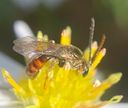Lasioglossum zephyrus
Classification
- Phylum: Arthropoda
- Subphylum: Hexapoda
- Class: Insecta
- Order: Hymenoptera
- Family: Halictidae
- Subfamily: Halictinae
- Tribe: Halictini
- Genus: Lasioglossum
- Species: zephyrus
Pronunciation
How to pronounce Lasioglossum zephyrus: /ˌlæsiˈoʊɡlɒsəm ˈzɛfɪrəs/
These audio files are automatically generated. While they are not always 100% accurate, they are a good starting point.
Images


Summary
Lasioglossum zephyrus is a sweat bee in the family Halictidae, characterized by distinctive coloration and behavior. It exhibits primitively eusocial behavior and has a significant role in its ecosystem as a pollinator.
Physical Characteristics
Dark green metallic color, reddish abdomen, and a hairier face than most other species. Males are distinguished by their brighter green color and redder abdomens. Length: Female 5.31–7.08 mm, Male 5.06–7.10 mm.
Identification Tips
Males are more colorful than females. Queens can be identified by their behavior, nudging subordinates.
Habitat
Nests are usually constructed in soil burrows along south-facing edges of streams. They are clustered in aggregations, sometimes up to 1,000 nests.
Distribution
Found throughout the United States, from British Columbia to Texas, east to Florida, and north to Maine.
Diet
Feeds on pollen from various flowers. Collects multiple types of pollen, depending on availability.
Life Cycle
New nests are established in April, with colonies reaching a maximum size of 10–20 individuals by August. Inseminated young queens overwinter in nests to repeat the cycle.
Reproduction
Colonies consist of one or more females; the queen does not collect pollen after the first batch of workers hatches. About 18% of workers may mate as well when the queen is present.
Predators
Parasitized by various organisms including bacteria, fungi, protozoa, and other hymenoptera species. Kleptoparasite Lasioglossum cephalotes and parasitoid mutillid Pseudomethoca frigida prey on it.
Ecosystem Role
Plays a role in pollination due to its flower-visiting behaviors.
Evolution
Considered a primitively eusocial bee, displaying both solitary and eusocial behaviors. Insight into the evolutionary background of eusociality due to social polymorphism within the genus.
Similar Taxa
Misconceptions
Common literature may reference it as 'zephyrum', which is a misspelling. The term 'zephyr' refers to a slight wind and is a noun, making the epithet non-changeable after taxonomic reassignment.
Tags
- Hymenoptera
- Halictidae
- sweat bee
- pollinator
- primitively eusocial